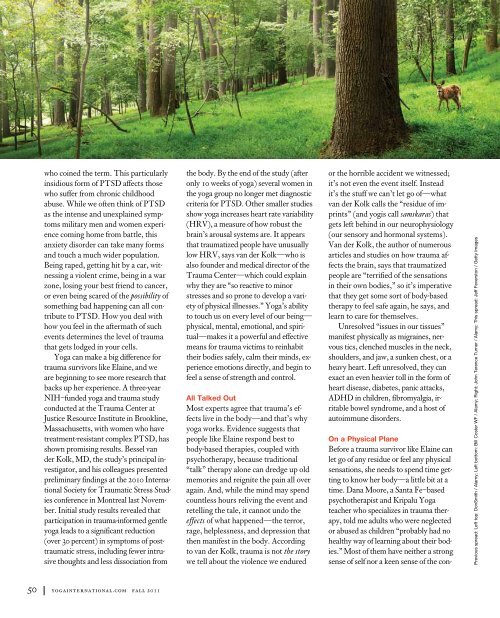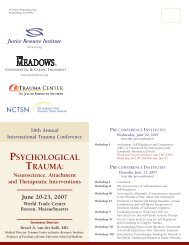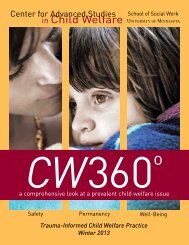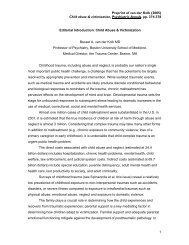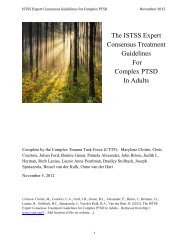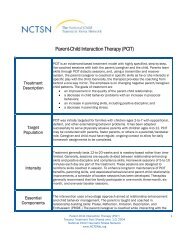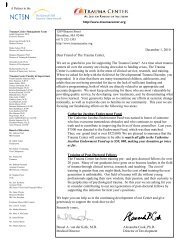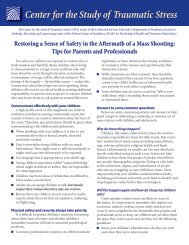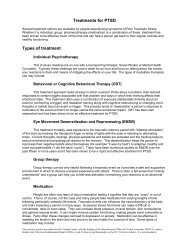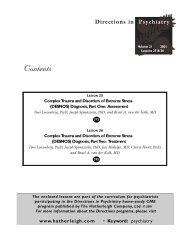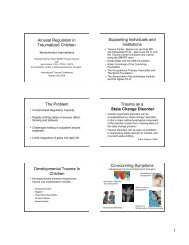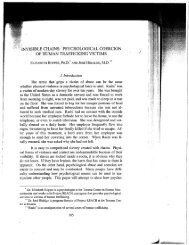Transcending Trauma - The Trauma Center
Transcending Trauma - The Trauma Center
Transcending Trauma - The Trauma Center
Create successful ePaper yourself
Turn your PDF publications into a flip-book with our unique Google optimized e-Paper software.
who coined the term. This particularly<br />
insidious form of PTSD affects those<br />
who suffer from chronic childhood<br />
abuse. While we often think of PTSD<br />
as the intense and unexplained symptoms<br />
military men and women experience<br />
coming home from battle, this<br />
anxiety disorder can take many forms<br />
and touch a much wider population.<br />
Being raped, getting hit by a car, witnessing<br />
a violent crime, being in a war<br />
zone, losing your best friend to cancer,<br />
or even being scared of the possibility of<br />
something bad happening can all contribute<br />
to PTSD. How you deal with<br />
how you feel in the aftermath of such<br />
events determines the level of trauma<br />
that gets lodged in your cells.<br />
Yoga can make a big difference for<br />
trauma survivors like Elaine, and we<br />
are beginning to see more research that<br />
backs up her experience. A three-year<br />
NIH–funded yoga and trauma study<br />
conducted at the <strong>Trauma</strong> <strong>Center</strong> at<br />
Justice Resource Institute in Brookline,<br />
Massachusetts, with women who have<br />
treatment-resistant complex PTSD, has<br />
shown promising results. Bessel van<br />
der Kolk, MD, the study’s principal investigator,<br />
and his colleagues presented<br />
preliminary findings at the 2010 International<br />
Society for <strong>Trauma</strong>tic Stress Studies<br />
conference in Montreal last November.<br />
Initial study results revealed that<br />
participation in trauma-informed gentle<br />
yoga leads to a significant reduction<br />
(over 30 percent) in symptoms of posttraumatic<br />
stress, including fewer intrusive<br />
thoughts and less dissociation from<br />
the body. By the end of the study (after<br />
only 10 weeks of yoga) several women in<br />
the yoga group no longer met diagnostic<br />
criteria for PTSD. Other smaller studies<br />
show yoga increases heart rate variability<br />
(HRV), a measure of how robust the<br />
brain’s arousal systems are. It appears<br />
that traumatized people have unusually<br />
low HRV, says van der Kolk—who is<br />
also founder and medical director of the<br />
<strong>Trauma</strong> <strong>Center</strong>—which could explain<br />
why they are “so reactive to minor<br />
stresses and so prone to develop a variety<br />
of physical illnesses.” Yoga’s ability<br />
to touch us on every level of our being—<br />
physical, mental, emotional, and spiritual—makes<br />
it a powerful and effective<br />
means for trauma victims to reinhabit<br />
their bodies safely, calm their minds, experience<br />
emotions directly, and begin to<br />
feel a sense of strength and control.<br />
All Talked Out<br />
Most experts agree that trauma’s effects<br />
live in the body—and that’s why<br />
yoga works. Evidence suggests that<br />
people like Elaine respond best to<br />
body-based therapies, coupled with<br />
psychotherapy, because traditional<br />
“talk” therapy alone can dredge up old<br />
memories and reignite the pain all over<br />
again. And, while the mind may spend<br />
countless hours reliving the event and<br />
retelling the tale, it cannot undo the<br />
effects of what happened—the terror,<br />
rage, helplessness, and depression that<br />
then manifest in the body. According<br />
to van der Kolk, trauma is not the story<br />
we tell about the violence we endured<br />
or the horrible accident we witnessed;<br />
it’s not even the event itself. Instead<br />
it’s the stuff we can’t let go of—what<br />
van der Kolk calls the “residue of imprints”<br />
(and yogis call samskaras) that<br />
gets left behind in our neurophysiology<br />
(our sensory and hormonal systems).<br />
Van der Kolk, the author of numerous<br />
articles and studies on how trauma affects<br />
the brain, says that traumatized<br />
people are “terrified of the sensations<br />
in their own bodies,” so it’s imperative<br />
that they get some sort of body-based<br />
therapy to feel safe again, he says, and<br />
learn to care for themselves.<br />
Unresolved “issues in our tissues”<br />
manifest physically as migraines, nervous<br />
tics, clenched muscles in the neck,<br />
shoulders, and jaw, a sunken chest, or a<br />
heavy heart. Left unresolved, they can<br />
exact an even heavier toll in the form of<br />
heart disease, diabetes, panic attacks,<br />
ADHD in children, fibromyalgia, irritable<br />
bowel syndrome, and a host of<br />
autoimmune disorders.<br />
On a Physical Plane<br />
Before a trauma survivor like Elaine can<br />
let go of any residue or feel any physical<br />
sensations, she needs to spend time getting<br />
to know her body—a little bit at a<br />
time. Dana Moore, a Santa Fe–based<br />
psychotherapist and Kripalu Yoga<br />
teacher who specializes in trauma therapy,<br />
told me adults who were neglected<br />
or abused as children “probably had no<br />
healthy way of learning about their bodies.”<br />
Most of them have neither a strong<br />
sense of self nor a keen sense of the con-<br />
Previous spread: Left top: DonSmith / Alamy; Left bottom: Bill Coster WF / Alamy; Right: John Terence Turner / Alamy; This spread: Jeff Feverston / Getty Images<br />
50 yogainternational.com fall 2011


